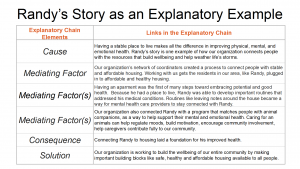How to Tell Your Success Stories
November 30, 2017As 2017 winds down, human service organizations join the broader nonprofit sector in making a final push for donations. Now is a good time to revisit a common year-end fundraising communications strategy, the story of the program participant. These stories often highlight individuals whose participation in a program helped them overcome personal challenges. But as we’ve discussed in previous newsletters (October 27, 2016 and November 10, 2016), tightly focusing the public’s attention on a particular person can backfire by cuing up the “Individualism Trap.”
 The FrameWorks Institute identified the Individualism Trap as one of the human service sector’s most significant communication challenges. When primed, the public is more likely to attribute a person’s well-being to his or her own actions and choices, rather than seeing the broader context and conditions that contribute to well-being. Through this lens, the public views human services as limited to direct, temporary interventions that address the basic needs of people in crisis. The ways in which human services promote well-being at many stages of life through strategies that include prevention, advocacy, and research are all pushed to the background. Moreover, the benefits of human services are viewed as limited to direct service recipients, while the benefits to society are invisible.
The FrameWorks Institute identified the Individualism Trap as one of the human service sector’s most significant communication challenges. When primed, the public is more likely to attribute a person’s well-being to his or her own actions and choices, rather than seeing the broader context and conditions that contribute to well-being. Through this lens, the public views human services as limited to direct, temporary interventions that address the basic needs of people in crisis. The ways in which human services promote well-being at many stages of life through strategies that include prevention, advocacy, and research are all pushed to the background. Moreover, the benefits of human services are viewed as limited to direct service recipients, while the benefits to society are invisible.
Still, when carefully framed, stories can be a powerful tool for engaging the public. In Storytelling for Social Change: A Wide Angle Lens Approach to Reframing (password: nhsa), a webinar conducted earlier this year on NHSA’s behalf, FrameWorks provided helpful guidance on how to include personal stories in communications. In particular, examples of individuals in our communications should contribute to telling a thematic story, one that helps the audience see the broader trends, systems, and solutions, rather than an episodic story, which focuses narrowly on an individual’s actions or challenges.
Watch the Webinar (pw: nhsa)
In one example highlighted in the webinar, The Story of Randy, FrameWorks walks through the process of turning an episodic story about how an organization helped one person into a thematic story about how an organization is addressing a challenge that impacts the entire community.
The Story of Randy – Original, Episodic Example:
Randy’s homelessness was further challenged by ongoing medical conditions which led to repeated hospitalizations. Due to his health, he struggled with organization and memory, making it difficult to tend to his needs appropriately. Once Randy had a stable place to live, he was able to leave reminders around his apartment about appointments, making trips to his mental health care providers more consistent. His new dog has helped Randy regulate his moods by providing him companionship and an outlet to remain motivated and engaged with his community.
This version of the story focuses on the importance of stable housing to Randy’s well-being. And while that story is true, it is incomplete. Important pieces of the story, like why homelessness should matter to the public, and how the organization addresses housing and homelessness, are left unexplained. Contrast that with FrameWorks’ reframed version below, which charts out the process of: 1) placing Randy’s story into the broader context of the what healthy, stable housing means for all of us; and 2) providing a deeper explanation of the organization’s role in fostering well-being throughout the community.


